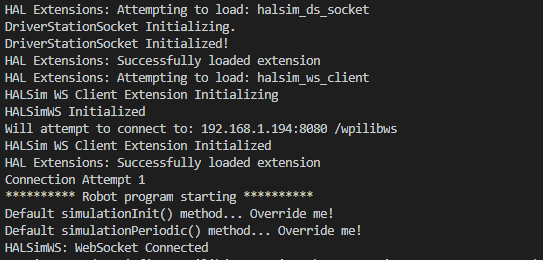@wpilib/wpilib-ws-robot-romi v1.4.0
wpilib-ws-robot-romi
Pololu Romi 32U4 Reference Robot for WPILib WebSocket Interface
Introduction
This repository contains a reference implementation of a robot that can be controlled via the WPILib HALSim WebSocket extensions. The chassis and controller are based around the Romi robot and associated Control Board from Pololu.
Usage with WPILib
For usage with WPILib, please take a look at the WPILib Romi documentation. It has more information on how to install the WPILibPi Raspberry Pi image, which comes packaged with the software needed to image your Romi robot, and provides useful status information.
Kit of Parts
NEW: Please see the WPILib Romi documentation for up-to-date information on the Romi hardware.
Software Dependencies
NEW: Please use the 2021 WPILib installer (Beta 4 or later) to install the necessary development software for use with the Romi.
Raspbery Pi Installation
NEW: For the latest information on how to image your Raspberry Pi for use with the Romi, please see the WPILib Romi documentation.
Controlling The Robot via WPILib
NEW: For the latest information on how to use WPILib with the Romi, please see the WPILib Romi documentation.
Running Robot Project
NEW: For the latest information on how to use WPILib with the Romi, please see the WPILib Romi documentation.
In your robot project, Hit F5 or run Simulate Robot Code on Desktop from the VSCode Palette (Ctrl+Shift+P).

Once your code compiles, a new selection dialog will appear. This lists all the extensions you had listed under dependencies in your build.gradle file. Select the halsim_ds_socket.[so/dylib/dll] and halsim_ws_client.[so/dylib/dll] options (file extension depends on your OS).

Upon clicking OK, your robot project should start running on the desktop, and you should something similar to the image below in your console:

If you see the line WebSocket Connected, you have established a connection to your robot! From this point, your WPILib-based robot code will trigger corresponding behaviors on the Romi (e.g. if you output HIGH on DigitalOutput channel 3, the yellow LED on the Romi will turn on). For more information about the pin mappings and assignments, see the firmware README.
Theory of Operation
This section provides more technical details on how this package works.
Communication Between Raspberry Pi and Romi 32U4 Board
The Raspberry Pi and Romi 32U4 boards are connected via the 40-pin connector, and communicate over I2C. The Romi firmware uses the Pololu Raspberry Pi interface library for Arduino to facilitate board-to-board communication.
Both boards essentially utilize a "shared memory buffer" to read/write to. The layout of this buffer can be found in the sharedmem.json file. Since both the firmware and JS code need to have the same buffer layout, the generate-buffer.js script reads in the sharedmem.json file and automatically generates a shmem_buffer.h file for the firmware and a romi-shmem-buffer.ts file for the Node application, thus keeping both sets of files in sync.
Application Structure
The main entry point for the application is src/index.ts. The file is fairly small and serves as a binding layer for the WPILibWSRomiRobot class (which is defined in src/romi-robot.ts) and the WPILibWSRobotEndpoint class (which is defined in the wpilib-ws-robot NPM package).
The wpilib-ws-robot package provides a wrapper around the guts of the WPILib WebSocket protocol, and allows developers to easily interface with other kinds of robots, simply by extending from the WPILibWSRobotBase class (also exposed by wpilib-ws-robot).
In the src/romi-robot.ts file, you can see how the defined class interacts with the Romi firmware over I2C.
The src/i2c folder contains both an I2C abstraction layer, and concrete implementations of a Raspberry Pi compatible I2C bus (src/i2c/hw-i2c.ts) and a mock I2C bus (src/i2c/mock-i2c.ts) that can be used for testing on non-Raspberry Pi platforms.
wpilib-ws-robot and node-wpilib-ws Packages
This application depends on the wpilib-ws-robot package (as mentioned above), which in turn depends on node-wpilib-ws. The node-wpilib-ws package contains the core classes that implement the WPILib WebSocket protocol, and the code can be found at its repository.
See the READMEs in each of the dependent packages to find out more about how to use them outside of this application.
5 years ago
5 years ago
5 years ago
5 years ago
5 years ago
5 years ago
5 years ago
5 years ago
5 years ago
5 years ago
5 years ago
5 years ago
5 years ago
5 years ago
5 years ago
5 years ago
5 years ago
5 years ago
5 years ago
5 years ago
5 years ago
5 years ago